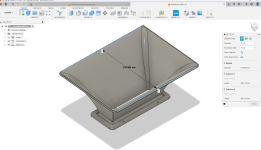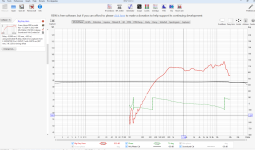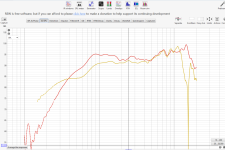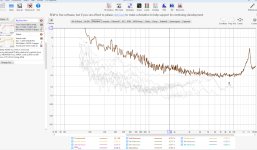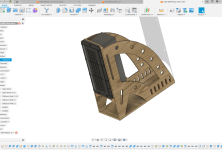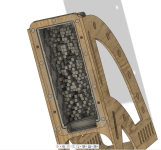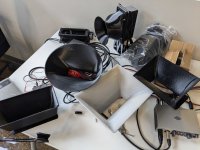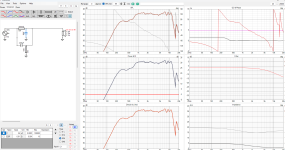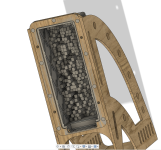For the last month I have been playing around with front horn loading an 8" planar mid driver from GRS.
https://www.parts-express.com/GRS-PT6825-8-8-Planar-Mid-Tweeter-8-Ohm-272-126?quantity=1
The idea was to flatten the response. It was quite erratic stock. Too erratic for my skill level to beat into submission.
I knew I could load it and flatten it, I just didn't know how. I started by just making all sorts of horns. I think I started with 6 different designs. Traditional, traditional with phase plugs, throated horns, etc. With this I found a pattern but knew I need to figure out Horn Resp. So I did.
Horn Resp has a hell of a learning curve. All the sim really shows you is the power. A planar mid has no specs that load into HornResp. I first had to find a driver whose specs reflect that of the planar. Not so easy. An excercise in pattern finding. I succeeded in finding a 4" Tang Band whose specs made do as a very good replacement for the planar.
I printed out 4 more horns to try. Now I had to find a pattern between the power response and the actual increase in SPL to frequency range of the driver. I found this with graphs. Its around 3.1 Db but its not that easy. More of a dark art as it does change throughout the frequency range.
I'll show some data here but the best performing horn is quite large, and quite wide. Too wide and long for its intended application which was my office monitor. Its length also causes issue crossing it since you have to add in the X offset. I could add the woofer far back behind the horn and get away with it but the tweeter would be a problem. I am unsure at this point how to create a notch filter that would knock down the entire range from 5k-15k hz. If someone knows how, let me know please.
What is most interesting to me about the horn loading is you can increase the lower range AND reduce distortion at the same time. You could EQ this driver up to make it respond flat but would do nothing for the drastically rising distortion. Horn loading it increases the SPL and decreases the distortion at once increasing its range dramatically.
I'm still working out how to cross this with some other drivers. This has very high sensitivity so pairing it with a woofer that hits low generally dictates a very large resistor.
Alright, now I'll add all the data and models.
Best horn is here: I call it Big Grey
https://www.parts-express.com/GRS-PT6825-8-8-Planar-Mid-Tweeter-8-Ohm-272-126?quantity=1
The idea was to flatten the response. It was quite erratic stock. Too erratic for my skill level to beat into submission.
I knew I could load it and flatten it, I just didn't know how. I started by just making all sorts of horns. I think I started with 6 different designs. Traditional, traditional with phase plugs, throated horns, etc. With this I found a pattern but knew I need to figure out Horn Resp. So I did.
Horn Resp has a hell of a learning curve. All the sim really shows you is the power. A planar mid has no specs that load into HornResp. I first had to find a driver whose specs reflect that of the planar. Not so easy. An excercise in pattern finding. I succeeded in finding a 4" Tang Band whose specs made do as a very good replacement for the planar.
I printed out 4 more horns to try. Now I had to find a pattern between the power response and the actual increase in SPL to frequency range of the driver. I found this with graphs. Its around 3.1 Db but its not that easy. More of a dark art as it does change throughout the frequency range.
I'll show some data here but the best performing horn is quite large, and quite wide. Too wide and long for its intended application which was my office monitor. Its length also causes issue crossing it since you have to add in the X offset. I could add the woofer far back behind the horn and get away with it but the tweeter would be a problem. I am unsure at this point how to create a notch filter that would knock down the entire range from 5k-15k hz. If someone knows how, let me know please.
What is most interesting to me about the horn loading is you can increase the lower range AND reduce distortion at the same time. You could EQ this driver up to make it respond flat but would do nothing for the drastically rising distortion. Horn loading it increases the SPL and decreases the distortion at once increasing its range dramatically.
I'm still working out how to cross this with some other drivers. This has very high sensitivity so pairing it with a woofer that hits low generally dictates a very large resistor.
Alright, now I'll add all the data and models.
Best horn is here: I call it Big Grey
Here are a bunch of the research horns. This isn't even all of them.
Attachments
-
 Screenshot 2024-11-18 212156.png488.7 KB · Views: 48
Screenshot 2024-11-18 212156.png488.7 KB · Views: 48 -
 Screenshot 2024-11-18 212212.png238.9 KB · Views: 59
Screenshot 2024-11-18 212212.png238.9 KB · Views: 59 -
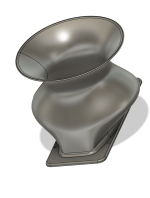 Screenshot 2024-11-18 212221.png366.5 KB · Views: 60
Screenshot 2024-11-18 212221.png366.5 KB · Views: 60 -
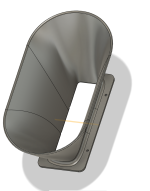 Screenshot 2024-11-18 212235.png338 KB · Views: 61
Screenshot 2024-11-18 212235.png338 KB · Views: 61 -
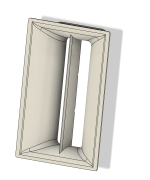 Screenshot 2024-11-18 212034.png180.3 KB · Views: 48
Screenshot 2024-11-18 212034.png180.3 KB · Views: 48 -
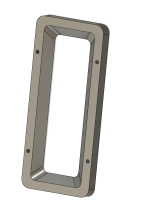 Screenshot 2024-11-18 212053.png81.6 KB · Views: 42
Screenshot 2024-11-18 212053.png81.6 KB · Views: 42 -
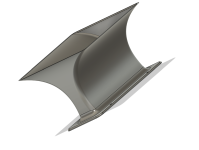 Screenshot 2024-11-18 212135.png321.5 KB · Views: 46
Screenshot 2024-11-18 212135.png321.5 KB · Views: 46 -
 Screenshot 2024-11-18 212143.png156.7 KB · Views: 49
Screenshot 2024-11-18 212143.png156.7 KB · Views: 49
I am printing one more horn to try but then am going to call it quits on this project.
I think to use this you'd need a very big horn in a large space. With the right horn you could use it as mid from 700-5k perfectly well. Again, that rising response at the top range is difficult to quell. I found a this is best used with a series crossover.
If anyone has used this transducer with success please let me know. I have some questions.
I did play music through it and it sounds really good within its designated frequency range.
I think to use this you'd need a very big horn in a large space. With the right horn you could use it as mid from 700-5k perfectly well. Again, that rising response at the top range is difficult to quell. I found a this is best used with a series crossover.
If anyone has used this transducer with success please let me know. I have some questions.
I did play music through it and it sounds really good within its designated frequency range.
I’m sharing my test results of the GRS PT6825-8 planar in a front horn. This driver responds well to horn loading providing low distortion down to 300Hz. IMD is -55dB even at 100dB SPL 1m. It’s nice to see an affordable replacement to the NEO8 become available.
Specification Sheet
Specification Sheet
- Joseph Crowe
- Replies: 7
- Forum: Planars & Exotics
https://josephcrowe.com/blogs/news/...orn-for-grs-pt6825-planar-tweeter-test-review
https://josephcrowe.com/blogs/news/open-back-or-sealed-rear-chamber
https://josephcrowe.com/blogs/news/positive-review-on-e-250-double-planar-front-horn
https://josephcrowe.com/blogs/news/e-250-dual-planar-front-horn
Yes, I saw Joseph Crowe's work on this driver when I was finishing up this work. I found we landed on a very similar horn shape though he continues the horn on for diffraction purposes.
I own this horn, but haven’t tried it yet, thinking of crossing over with an active linkwitz crossover at 350hz to pure audio 15” drivers in open baffle. I have 4 of these drivers, but will start with 2. I’m a beginner and have been stopped by not having the skills or workshop to cut the holes for the 15” drivers
Last edited:
Nice work! You went far in your exploration. 👍am unsure at this point how to create a notch filter that would knock down the entire range from 5k-15k hz. If someone knows how, let me know please.
Don't know about a passive notch filter that broad, but it's easy with a high shelf filter in miniDSP -- and probably other digital crossovers or PEQ devices.
The wideband notch filter calculator on this page starts with -15dB minimum, but studying for formulas might help provide a solution.
https://www.learningaboutelectronics.com/Articles/Notch-filter-calculator.php
https://www.learningaboutelectronics.com/Articles/Notch-filter-calculator.php
Did you have the horn CNC cut & assemble it yourself? I trust you have 2? Looks like it needs a lot of BB plywood.I own this horn, but haven’t tried it yet, thinking of crossing over with an active linkwitz crossover at 350hz to pure audio 15” drivers in open baffle. I have 4 of these drivers, but will start with 2. I’m a beginner and have been stopped by not having the skills or workshop to cut the holes for the 15” drivers
Great!Thank you so much for the notch filter calc link. It worked perfectly
I see Big Grey is 21cm wide. What are the other dimensions? Surely that cost more than $4 of feed stock! What are you doing with the back wave?
Nope, its still about $4. They are all pretty thin. Only 3mm thick walled so its about 250 grams per. Thats 1/4 of a $12 roll of filament.
The other's dimensions vary. As a generalization, you need length and/or a wide opening to add power lower down the range. The more narrow the openeing the more direct it is as well.
I have designed a back cup that I fill with foam. It is a dispersion thingy. You can have the STEP file if you want to make one.
The other's dimensions vary. As a generalization, you need length and/or a wide opening to add power lower down the range. The more narrow the openeing the more direct it is as well.
I have designed a back cup that I fill with foam. It is a dispersion thingy. You can have the STEP file if you want to make one.
Attachments
And is 3mm thick enough for reasonable rigidity?
I'd happily accept your STEP file offer. Or STL? Can't recall what my 3D print provider prefers.
I'd happily accept your STEP file offer. Or STL? Can't recall what my 3D print provider prefers.
You should check out the design of the Dayton Audio PHT1-6.
it uses a spilt throat to raise upper cutoff directivity. These sound very good for a horn of this design. I've used it in monitor builds and light duty PA, but there's nothing really light duty about them.
it uses a spilt throat to raise upper cutoff directivity. These sound very good for a horn of this design. I've used it in monitor builds and light duty PA, but there's nothing really light duty about them.
- Home
- Loudspeakers
- Multi-Way
- Planar Horn Research - Findings
